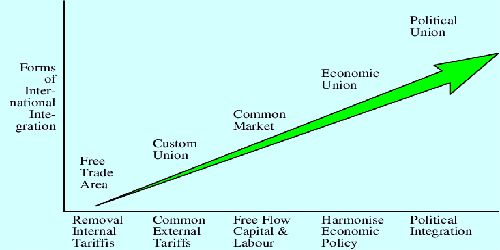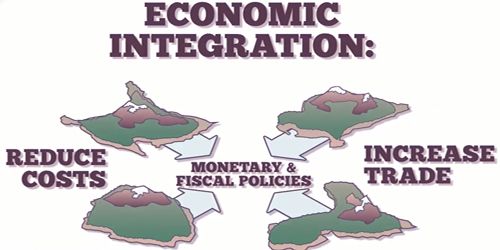Economic integration is the unification of economic policies between different states through the partial or complete abolition of tariffs and the imposition of duty-free restrictions on trade. Economic integration is an agreement between countries in a geographical region reduces and ultimately removes, hinders the free flow of duty and non-duty goods or service and production reasons between each other; any kind of arrangement which countries agree to coordinate their trade, monetary and monetary policies Referred to as economic integration. The term has a brief history of its own; In fact, Matchup (1977) did not find a single example of its use before 1942. It is in its political dimension that economic integration differs from the broader concept of regionalism in general. By the 1950s, however, the term had an international definition, specifically defining international trade as referring to the state of a state or a process that extends to a larger area of the individual economy, and the term is used today in a more limited sense.
There are types of regional economic integration:

Economic integration
- Free trade area: In this case, tariff barriers to trade in goods between member countries are removed but each country maintains control over its own trade policy; this means that certain types of barriers are effectively maintained. The North Atlantic Free Trade Agreement (NAFTA) is an example of such a free trade zone and includes the United States, Canada, and Mexico. The general goal of free trade agreements is to develop economies of scale and comparative advantage, which increase economic efficiency.
- Customs Union: Customs involves removing tariff barriers between union members and levying general (consolidated) external duties against non-members. Custom unions are particularly effective in leveling the competitive playing field and resolving export problems (using preferred tariffs in one country to enter another). As in the case of free trade, goods and services are traded freely among members. Also, the customs union establishes a general trade policy with respect to non-members. The customs union was based on the creation of a common customs duty (CCT) with respect to other parts of the world. At the same time, tariffs were abolished among its member countries.
- Common market: The tariff union in the general market has the same characteristics; however, the manufacturing material (labor, capital, and technology) is mobile among the members. However, each national market has its own regulations on the quality of such products. The primary advantage of workers is that they no longer need a visa or work permit to work in another member country of the general market.
- Economic Union: This is the last step in an economic integration process. In addition to the free movement of goods, services, and manufacturing factors, there is a need for integration of both monetary and economic policies. The fiscal and fiscal policies of the member countries are integrated, which refers to a level of political integration. Another step relates to the currency union where a common currency is used, such as with the European Union (Euro). For the characteristics of the single market, there was a need to add greater integration and coordination in a few more areas, such as foreign policy and equity.
- Political union: As the economies of co-operating countries become fully integrated into a single market, so do social policies (education, healthcare, unemployment benefits, and pensions) and general policies in general political institutions. Only found in national-states, such as federations where the central government and territories (provinces, states, etc.) have a level of autonomy. This is the political unification and its culmination when the co-operative countries are so united that they share the same foreign policy and unify their armies.














